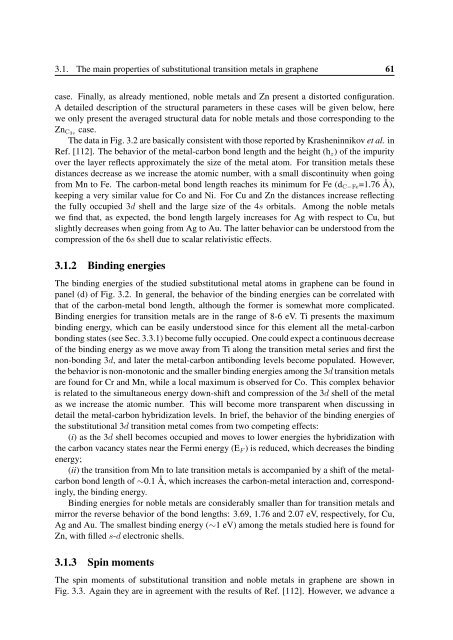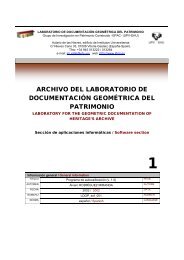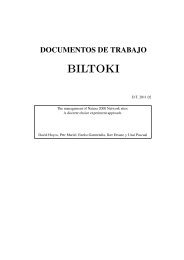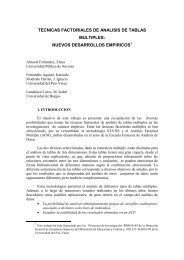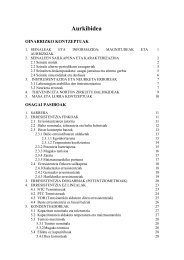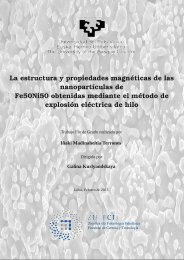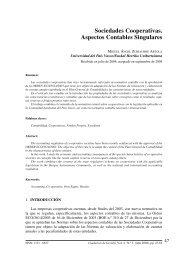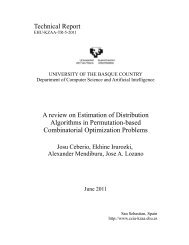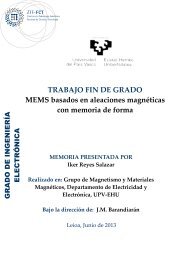Ï - ADDI
Ï - ADDI
Ï - ADDI
- No tags were found...
Create successful ePaper yourself
Turn your PDF publications into a flip-book with our unique Google optimized e-Paper software.
3.1. The main properties of substitutional transition metals in graphene 61case. Finally, as already mentioned, noble metals and Zn present a distorted configuration.A detailed description of the structural parameters in these cases will be given below, herewe only present the averaged structural data for noble metals and those corresponding to theZn C3v case.The data in Fig. 3.2 are basically consistent with those reported by Krasheninnikov et al. inRef. [112]. The behavior of the metal-carbon bond length and the height (h z ) of the impurityover the layer reflects approximately the size of the metal atom. For transition metals thesedistances decrease as we increase the atomic number, with a small discontinuity when goingfrom Mn to Fe. The carbon-metal bond length reaches its minimum for Fe (d C−Fe =1.76 Å),keeping a very similar value for Co and Ni. For Cu and Zn the distances increase reflectingthe fully occupied 3d shell and the large size of the 4s orbitals. Among the noble metalswe find that, as expected, the bond length largely increases for Ag with respect to Cu, butslightly decreases when going from Ag to Au. The latter behavior can be understood from thecompression of the 6s shell due to scalar relativistic effects.3.1.2 Binding energiesThe binding energies of the studied substitutional metal atoms in graphene can be found inpanel (d) of Fig. 3.2. In general, the behavior of the binding energies can be correlated withthat of the carbon-metal bond length, although the former is somewhat more complicated.Binding energies for transition metals are in the range of 8-6 eV. Ti presents the maximumbinding energy, which can be easily understood since for this element all the metal-carbonbonding states (see Sec. 3.3.1) become fully occupied. One could expect a continuous decreaseof the binding energy as we move away from Ti along the transition metal series and first thenon-bonding 3d, and later the metal-carbon antibonding levels become populated. However,the behavior is non-monotonic and the smaller binding energies among the 3d transition metalsare found for Cr and Mn, while a local maximum is observed for Co. This complex behavioris related to the simultaneous energy down-shift and compression of the 3d shell of the metalas we increase the atomic number. This will become more transparent when discussing indetail the metal-carbon hybridization levels. In brief, the behavior of the binding energies ofthe substitutional 3d transition metal comes from two competing effects:(i) as the 3d shell becomes occupied and moves to lower energies the hybridization withthe carbon vacancy states near the Fermi energy (E F ) is reduced, which decreases the bindingenergy;(ii) the transition from Mn to late transition metals is accompanied by a shift of the metalcarbonbond length of ∼0.1 Å, which increases the carbon-metal interaction and, correspondingly,the binding energy.Binding energies for noble metals are considerably smaller than for transition metals andmirror the reverse behavior of the bond lengths: 3.69, 1.76 and 2.07 eV, respectively, for Cu,Ag and Au. The smallest binding energy (∼1 eV) among the metals studied here is found forZn, with filled s-d electronic shells.3.1.3 Spin momentsThe spin moments of substitutional transition and noble metals in graphene are shown inFig. 3.3. Again they are in agreement with the results of Ref. [112]. However, we advance a


